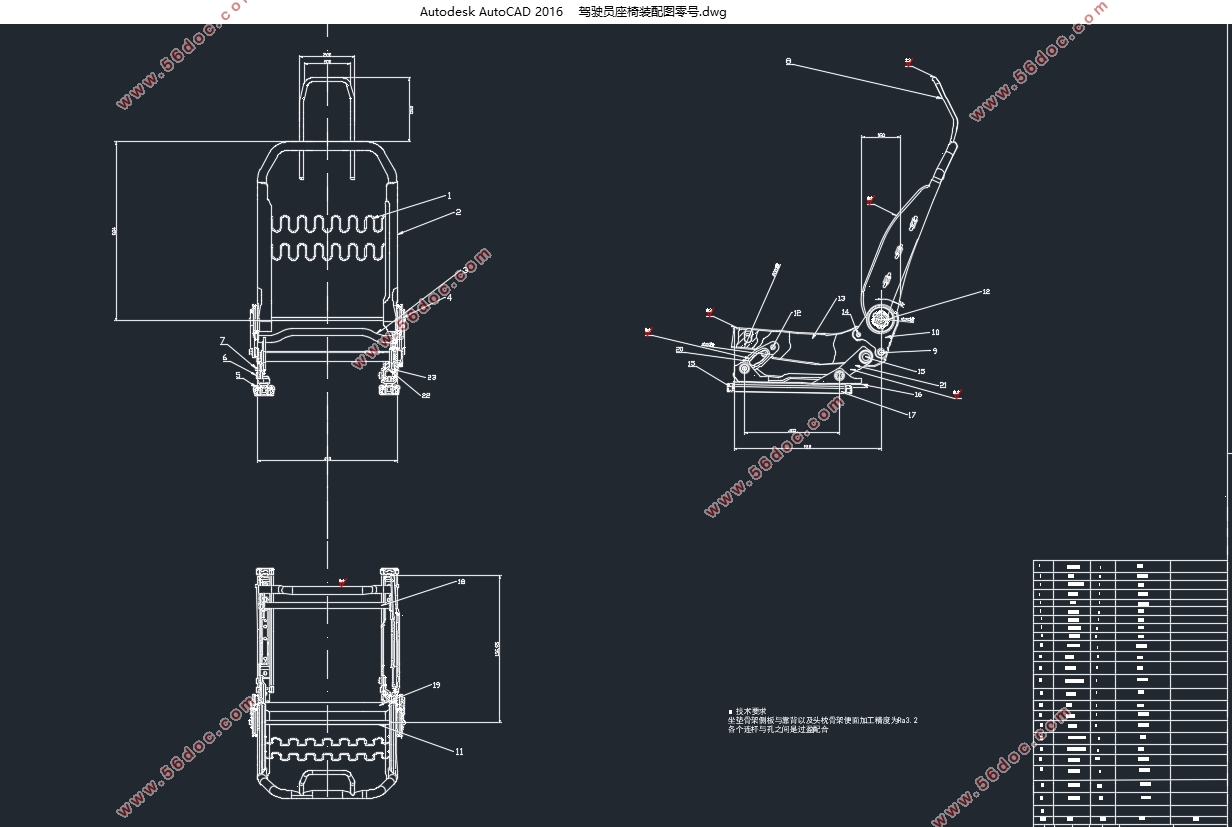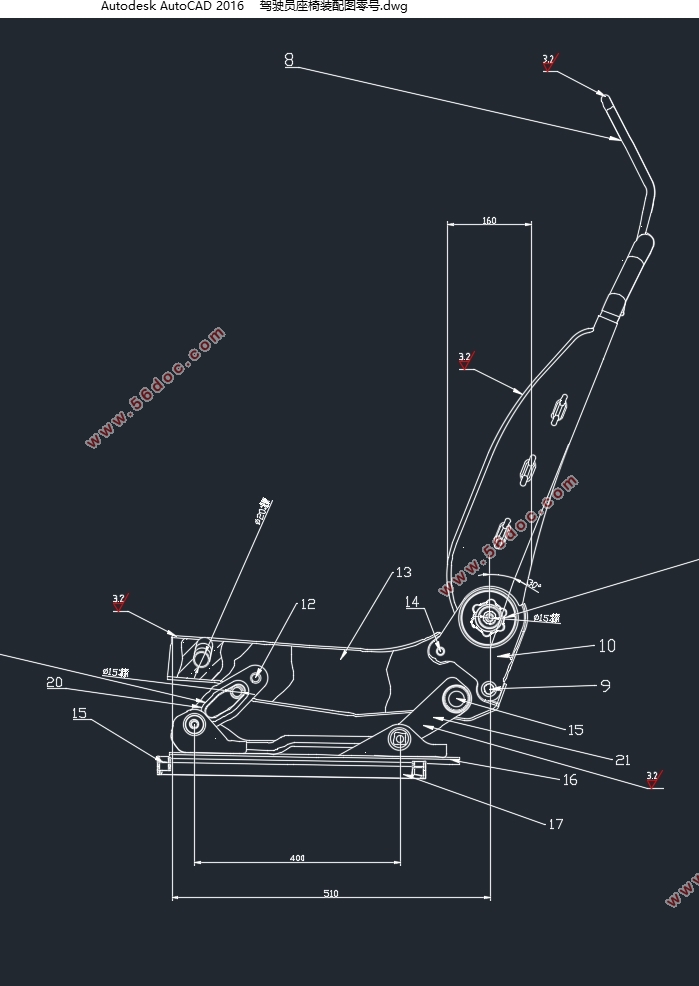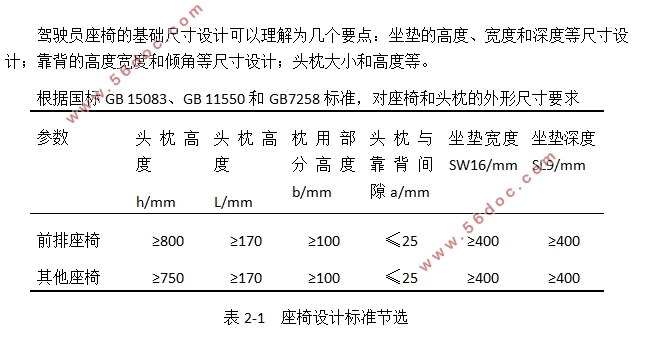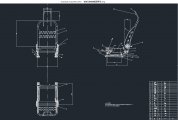家用中型轿车驾驶员座椅设计(含CAD零件图装配图)
来源:56doc.com 资料编号:5D25291 资料等级:★★★★★ %E8%B5%84%E6%96%99%E7%BC%96%E5%8F%B7%EF%BC%9A5D25291
资料以网页介绍的为准,下载后不会有水印.资料仅供学习参考之用. 密 保 惠 帮助
资料介绍
家用中型轿车驾驶员座椅设计(含CAD零件图装配图)(任务书,开题报告,文献摘要,外文翻译,论文说明书13000字,CAD图6张)
摘要
汽车座椅作为现代汽车工业的一个重要的产品,设计水平的高低将决定了整车的使用体验。本文将依托与现有的实际案例,先确定大体的设计参数外形尺寸。同时配合以目标人群的外形尺寸参数,在行业标准符合的框架内设置各个零部件的尺寸参数。选择目标人群时充分考虑到实际情况,经设计余量提前做好。并利用CATIA软件进行建模。建立了模型之后,通过使用ANSYS进行有限元分析,并将有限元的的分析结果与数学计算的结果相比较,测试其是否符合强度要求。对于座椅舒适性,重点放在了静态舒适性上面,通过对人体的具体形态进行分析,对驾驶员座椅的详细参数进行确定。最后达成一个相对而言比较完善的图纸设计。完成的设计成果能够实现健胃舒适的驾驶姿势并大体符合人机工程学。参考车型:斯柯达明锐1.6紧凑型轿车。
关键词:汽车座椅;人机工程;舒适性;
Abstract
As an important product of the modern automobile industry, the design level of the car seat will determine the experience of the vehicle. Based on the existing practical cases, this paper first determines the overall design parameters. At the same time, the dimension parameters of each part are set in the frame of the industry standard. When selecting the target group, the actual situation should be fully taken into consideration, and the design balance should be completed in advance. CATIA software is used for modeling. After the model was established, the finite element analysis was carried out by using ANSYS, and the results of the finite element analysis were compared with the results of the mathematical calculation to test whether it met the strength requirements. For seat comfort, the emphasis is on static comfort, and the detailed parameters of the driver's seat are determined by analyzing the specific form of the human body. Finally, a relatively perfect drawing design is achieved. The completed design results can achieve the comfortable driving posture of the stomach. It is generally ergonomic.Reference model: Skoda Octavia 1.6 compact car.
Key Words: Car seat;Ergonomics;Comfort;3D model




目录
第一章 绪论 1
1.1 选题背景及意义 1
1.2 驾驶员座椅设计的大致思路与业内的研究现状 2
1.2.1 国外研究现状 2
1.2.2 国内研究现状 2
1.3 本次毕业设计的主要研究内容 4
第二章 基于目标人群身体参数的基础计算 4
2.1 人体静态尺寸 5
2.2 座椅尺寸技术要求设计 6
2.2.1 椅面高度 6
2.2.2 座椅H点确定 7
2.2.3 驾驶员座椅调节行程计算 8
2.3 座椅基本参数的初步确定 9
2.4 参考车型的实测数据 9
第三章 座椅强度设计 10
3.1 座椅靠背强度设计 10
3.1.1 靠背受力分析和计算 10
3.1.2 驾驶员座椅靠背强度设计 10
3.1.3 驾驶员座椅靠背anysy应力分析 11
3.2 调角器强度设计: 12
3.2.1 头枕受力分析和弯矩计算 13
3.2.2 头枕骨架应力计算 13
3.2.3 座椅头枕强度ansys验证 14
第四章 座椅舒适性 15
4.1 人体坐姿生理特性 15
4.2 座椅轮廓及尺寸 16
4.2.1 坐垫长度 16
4.2.2 坐垫宽度和景中宽度 16
4.2.3 坐垫角 17
4.2.4 坐垫厚度和坐垫压陷量 17
4.2.5 坐垫离去点 18
4.2.6 座靠咬合线位置 18
4.2.7 人体与骨架的距离 18
4.3 座椅靠背 19
4.3.1 靠背高度 19
4.3.2 腰部支撑 19
4.3.3 靠背旋转点位置 19
4.3.4 腰部支撑轮廓 20
4.3.5 人与靠背骨架的距离 20
4.4 座椅头枕位置 20
4.5 动态舒适性 22
第五章 总结 24
参考文献 25
致谢 26
|









